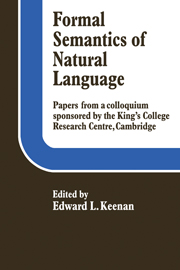Book contents
- Frontmatter
- Contents
- Notes on the contributors
- Acknowledgements
- Introduction
- I QUANTIFICATION IN NATURAL LANGUAGE
- II REFERENCE AND CROSS REFERENCE
- III INTENSIONAL LOGIC AND SYNTACTIC THEORY
- IV QUESTIONING MODEL THEORETIC SEMANTICS
- V PRAGMATICS AND SENTENCES IN CONTEXT
- VI SEMANTICS AND SURFACE SYNTAX
- Arguments for assigning tense meanings after certain syntactic transformations apply
- Towards a formal treatment of the phenomenon of aspect
- On the relations between syntax and semantics
- Logical expressive power and syntactic variation in natural language
Arguments for assigning tense meanings after certain syntactic transformations apply
Published online by Cambridge University Press: 05 November 2011
- Frontmatter
- Contents
- Notes on the contributors
- Acknowledgements
- Introduction
- I QUANTIFICATION IN NATURAL LANGUAGE
- II REFERENCE AND CROSS REFERENCE
- III INTENSIONAL LOGIC AND SYNTACTIC THEORY
- IV QUESTIONING MODEL THEORETIC SEMANTICS
- V PRAGMATICS AND SENTENCES IN CONTEXT
- VI SEMANTICS AND SURFACE SYNTAX
- Arguments for assigning tense meanings after certain syntactic transformations apply
- Towards a formal treatment of the phenomenon of aspect
- On the relations between syntax and semantics
- Logical expressive power and syntactic variation in natural language
Summary
In this paper I will consider a topic previously treated by T. R. Hofmann (1969). Hofmann proposes a solution in his article to the problem posed by the ambiguity of the English surface verbal form ‘have + past participle’ (i.e. ‘have – V – en’) in those dependent clauses whose verbs cannot exhibit either a present or simple past tense morpheme. Such clauses are the so-called ‘non-finite’ clauses: participles, gerunds, and infinitives of various types. I will examine and expand on Hofmann's solution, try to show its inadequacies, and then propose what I hope is a more promising alternative. In my proposal, the semantic tense values of clauses are assigned according to the distribution of tense markers in trees, subsequent to the application of certain syntactic transformations.
I have been greatly aided by the discussion of tense in chapters XXIII and XXIV of O. Jespersen (1964), to which I will be referring throughout the paper.
At the outset I want to emphasize that in my analysis, as in Hofmann's, syntactic tense markers occur not only in surface structure but also, with different and more regular distribution, in syntactic deep structures. That is, the deep structure existence of these syntactic tense markers is justified by the fact that we can more easily characterize their distribution in deep structure; yet, I will claim that these markers contribute to meaning only by virtue of their position in trees subsequent to the application of many transformational rules.
Information
- Type
- Chapter
- Information
- Formal Semantics of Natural Language , pp. 351 - 372Publisher: Cambridge University PressPrint publication year: 1975
Accessibility standard: Unknown
Why this information is here
This section outlines the accessibility features of this content - including support for screen readers, full keyboard navigation and high-contrast display options. This may not be relevant for you.Accessibility Information
- 1
- Cited by
